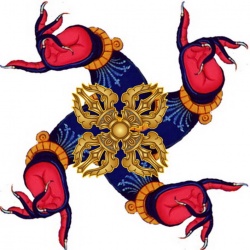Ten kings of hell
In Meido, where people go after death, there are 10 kings including Enra-o (Enra King), who judge the sins of the dead.
The dead are judged by each king on each occasion including every seventh day between Shonanoka (the 7th day after death) and Nanananoka (the 77th day after death), Hyakkanichi (the 100th day after death),
Isshuki (one year after death) and Sankaiki (three years after death) to determine which place in Rokudo (the six paths of karmic reincarnation) they should be reincarnated.
In China, Juo-zu was already seen in the Five Dynasties period (Tenth century) and many works by Buddhist painters in Myoshu (the present Neiha, Sekkosho) drawn in the period between the Sung period and Yuan period were brought to Japan.
One of them is the painting drawn by [[Riku]Shinchu]].
Although the Rakkan (artist signature) on some of these painting have been damaged, the handwriting matches one of his other works, "Busunehan-zu," held in this museum.
Each of the 10 paintings represents a King with officers of Meido going to a desk and sitting on a chair while examining the sins of the dead.
In front of each king, scenes of the dead who are waiting for judgment or who are receiving punishment after being found guilty are drawn with demons as prison officers.
Rich expressions created by accurate drawing and bright coloring are unique to Riku Shinchu.
Suiboku Sansui-zu (ink landscape painting) are drawn on all the screens behind the kings and
it is considered that these paintings represented in pictures within pictures have played a part in introducing Suiboku painting in Japan.
